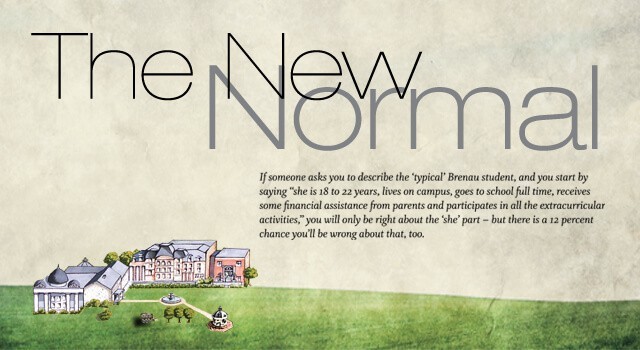The New Normal
This October marks the 31st anniversary of a significant milestone in the Brenau University demographic history. That is when institution officials reported that the enrollment in Brenau Women’s College was 824 students. However, the enrollment in what was then known as the “evening and weekend” program was 920 – the first time the latter number exceeded the former.
Since then, the so-called nontraditional student segment has grown past 2,000, counting those attending undergraduate and graduate school classes on all five Brenau campus around Georgia and more than 350 who take all their classes from Brenau online. Meanwhile, the Women’s College population remains static at between at 800 and 900 students.
“Brenau University has not abandoned the Women’s College experience and, as long as I have anything to do with it, it never will,” says Brenau President Ed Schrader. “But the reality is that Brenau is a total university with a variety of learning experiences. By far the largest segment of our student body is now and will be in the future the nontraditional students.”
In its 2025 strategic plan, the university anticipates growth from the current student population of about
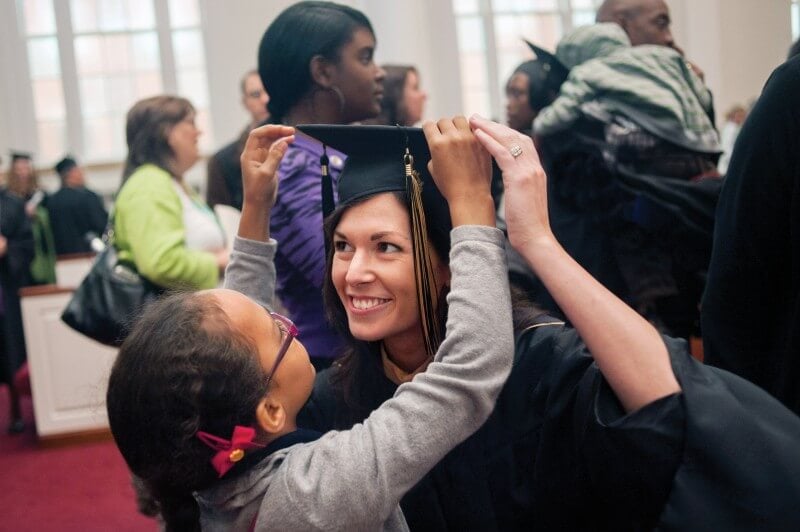
2,800 to 5,000 with the Women’s College remaining between 850 and 900. The Women’s College part of the plan recognizes two realities: First, the Gainesville campus, where the Women’s College has resided for 135 years, cannot physically support a residential institution much larger than its current level. More important, demand for a single-gender institution, while still strong enough to justify the existence of the Women’s College, has diminished substantially in the four decades since Brenau launched the nontraditional programs in the mid-1970s. Then there were about 300 all-female colleges in the United States. Today there are 47.
The simple truth is that today there are far more undergraduate students over 30 in America’s colleges and universities than there are the stereotypical 18- to 22-year-olds, which actually make up less than a sixth of the overall undergraduate populations. The National Center for Education Statistics reports that just 15 percent of today’s more than 17.6 million undergraduates attend four-year colleges and live on campus.
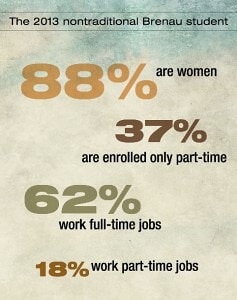 Nationally, thirty-two percent work full-time jobs and 37 percent are enrolled only part time. Of those who are enrolled in four-year college programs, just 36 percent actually graduate in four years.
Nationally, thirty-two percent work full-time jobs and 37 percent are enrolled only part time. Of those who are enrolled in four-year college programs, just 36 percent actually graduate in four years.
Frederick Hess, director of education policy studies for American Enterprise Institute, the politically conserv
ative Washington think tank, said that the most significant trend in higher education is this explosion of growth for adult learners. In a 2011 article in The Atlantic, “Old School: College’s Most Important Trend is the Rise of the Adult Student,” Hess reported that 38 percent of those enrolled in higher education are over 25. The share of students over 25 is projected to increase another 23 percent by 2019.
Although Brenau’s 2025 strategic plan focuses significantly on expanding graduate degree programs, like the proposed doctorates in physical therapy and occupational therapy with target start dates next year, the university’s success also will depend on how well it serves that booming nontraditional undergraduate population, Schrader says.
Scott Briell, senior vice president for enrollment and student services, says recruiting and retaining those students is a considerable challenge that will require Brenau to become more aggressive in a highly competitive market filled with not-for-profit private institutions, state and local government supported colleges and universities and the for-profit schools that spend tons of money on slick television commercials and other advertising in full-out marketing programs. Likewise, Nancy Krippel, Brenau provost and vice president for academic affairs, says the nontraditional segment places demands on higher education to deliver courses and programs that are relevant and convenient for adult learners.
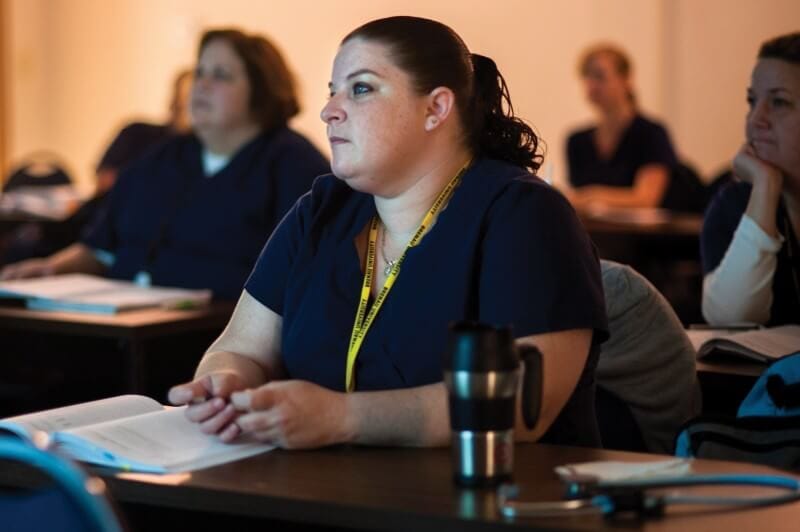
“A semester system works swell for 19-year-olds used to the rhythms of high school,” Hess wrote in his Atlantic article, “but it is hugely frustrating for workers whose schedule may not fit the academic calendar or unemployed workers trying to get retrained in a hurry.” Hess recommended that colleges and universities address needs of nontraditionals by, among other things, hiring more practicing professionals to teach when that is appropriate, ensuring that there are new courses that are starting continuously, not just in August and January, and making certain that assessment, syllabi and other class materials and processes are top quality.
“You hit a lot of bumps in the road when you first come back, especially if you’re working and have a family at home, too,” says Charnella Rosas, a 34-year-old undergraduate nursing student from Gwinnett County, Ga., who commutes to Brenau’s main campus in Gainesville for classes. Rosas began work on a nursing degree in 2008. As a part-time student, she anticipates graduating in May 2015.
“It’s hard when you get off work at 6:30 in the evening and you still have to study and four nights a week you’re in class until 10 o’clock and you live 30 or 40 minutes away,” she says. “But, this is just what you have to do to get it done.”
Who Are the Nontrads?
That seven-year time frame obviously is not your mother’s four-year college cycle. However, for nontraditionals like Rosas, who has a full-time job and a husband at home, it is closer to the norm.
Louis Soares, policy advisor to the American Council on Education, says that the nontraditional segment is “reshaping the demand for postsecondary education in the 21st century into a more fluid form of college-going with longer, episodic participation.” By his definition, outlined in a recent report entitled “Post-traditional Learners and the Transformation of Postsecondary Education: A Manifesto for College Leaders,” Soares identifies the nontraditional student as a 25- to 64-year-old working adult who has not yet earned a post-secondary credential.
According to Soares, adult learners are usually wage earners for themselves or their families. They combine work and learning, frequently moving between the two. They seek knowledge, skills and credentials that employers will recognize and for which they will be compensated. However, they require different maintenance requirements of their colleges and universities than traditional students: They frequently require developmental education to be successful in college-level courses since many of them, for example, have not been in a math class since Euclid was a freshman, and they demand heavy academic and career advising along their divergent paths to degrees.
The Center for Postsecondary and Economic Success revealed in a 2008 survey that a third of nontraditional undergraduates were parents – half of that number single parents.
Part-time enrollment, by some definitions a determining factor of non-traditional status, may account for a large proportion of college students. About 46 percent of postsecondary students are enrolled part-time.
In addition to bringing the definition of nontraditional students into sharper focus, there is also the ongoing debate around the world – and, indeed, around the Brenau campuses – as to what to call them. Nontraditional students, or adult learners, currently seem to have the edge among the preferred misnomers. “Working learners” and “post-traditional learners” jump in the mix in some locales. The Brits call them “mature students.”
“We wrestled with the ‘nontraditional’ term on our campus several years ago,” says Mary Sward, marketing coordinator at Johnson & Wales University in Providence, R.I. “At that time, we talked about replacing it with ‘adult learners,’ but realized that traditionally aged students think of themselves as adults, too. Unfortunately, we never did find an appropriate synonym.”
Pat Frantz Cercone, director of communications and marketing at University of Pittsburgh at Bradford, says “the problem with ‘working learners’ in this economy is that many are not working. We tend to talk about adults with family or work obligations, busy schedule, etc., without giving them a name.”
Part of the need to qualify these students as some sort of subset possibly stems from the fact that many of the programs for them evolved from operations that sometimes were regarded as stepchildren to “real” college. For example, Alabamans in the 1950s and ’60s commonly referred to the University of Alabama at Birmingham as “the extension center” for the main campus in Tuscaloosa. Some institutions had (and have) strangely confusing names, like the seemingly double redundancy of the University of Maryland’s University College. Some were almost poetically named, such as the University of Massachusetts at Amherst’s University Without Walls.
Brenau’s program, launched in the 1970s, carried until just a few years ago the name “Evening & Weekend College” because all the students enrolled attended classes, as the name implies, on weekends and weeknights. Even in the pages of this magazine, you will find a differentiation between Women’s College alumnae (there will be a “WC” designation after their names with a class year) and the nontraditional alumni (“EWC” and “O” may follow their names).
That is changing, however. No differentiation appears on any Brenau diploma, and in any university materials references to evening and weekend programs are merely references to when classes are scheduled. Gone, too, is the nomenclature for “Online College” since many Brenau students, including those enrolled as full-time residential students in the Women’s College, take at least one class online each semester.
In 1974-75, the year before the Evening & Weekend program began, Brenau College, which was only the single-gender Women’s College, enrolled only 521 students. The first year the new coeducational adult learners program began, 24 students enrolled. In 1994, after Brenau gained university status and began offering graduate programs, the nontraditional population had grown to 1,521 while the Women’s College enrolled 584.
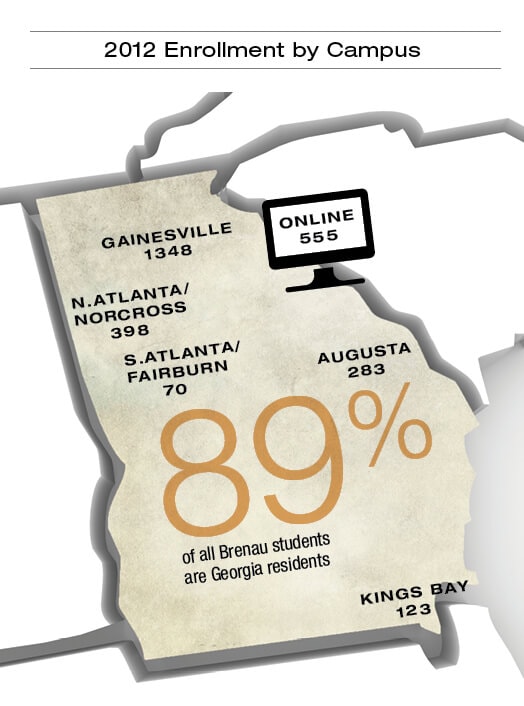 The official Brenau enrollment for the 2012-13 academic year stands at 2,777 students – 822 in the Women’s College and the rest in other graduate and undergraduate programs, a 31 percent growth in the last decade.
The official Brenau enrollment for the 2012-13 academic year stands at 2,777 students – 822 in the Women’s College and the rest in other graduate and undergraduate programs, a 31 percent growth in the last decade.
“More than 1,400 of those are returning adults,” says Rosanne Short, the Gainesville campus director and a Brenau alumna who did two stints as a nontraditional student. “Most of our adult students have had some college along the way, so they transfer in, but some do start as freshmen.”
The official enrollment for the “Gainesville campus,” which is the designation for the nontraditional enrollment even though the Women’s College is also located on the Gainesville campus, was 526. However, Brenau Provost Krippel says that she is amazed that, among the roughly 400 commuters who are enrolled as “day students” in the Women’s College, “we have a large number of women with a child, or two or three children.” That fact means at least some of the students, typically counted as “traditional” because of how they are enrolled, could just as easily be counted as nontraditional students. So, even on the Gainesville campus “nontraditional” students are fast becoming the new majority.
Here are some other facts about the nontraditional group at Brenau:
In 1994, 22.5 percent of the nontraditionals were male. Today only 12 percent are men. About 80 percent in 1994 were Caucasian. Today that number is 56 percent. About 31 percent are African-American and about six percent are Hispanic. Two percent identify themselves ethnically as Asian and three percent identify themselves as multiracial. Close to 60 percent are “first generation,” the first in their immediate families with any higher education experience.
About 12.5 percent, 241 in the 2012-13, academic year, receive military discounts on tuition. They are either active duty military, reservists or National Guard members, veterans, civilian employees of the military on bases like the U.S. Navy submarine base at Kings Bay, Ga., where Brenau has a campus, or dependents of some of those.
In 1994, 80 percent of Brenau’s nontraditional students officially were Georgia residents. That number increased to 93 percent in 2012-13.
Yet, only 15 percent of the Brenau nontraditional students receive the state aid because it is only available for undergraduate programs. Most Brenau nontraditionals are graduate students.
However, 64 percent receive federal Pell Grants, a need-based grant for low-income students, and 16 percent receive scholarships or grant funding from the university – again limited to undergraduates – for an average of $5,242 annually. Many of Brenau’s nontraditional undergraduates, like their traditional counterparts, see additional higher education in their futures after they receive bachelor’s degrees, says Senior Vice President Scott Briell.
“Based on the exit interviews that we have conducted, 30 percent of all Brenau undergrad students have shared that they’d want to enter grad school. Some have said they will start immediately while others say they will take a break and start some years later. Students with teaching degrees top the list of those who have expressed interest to continue higher education. Students who want an M.B.A., whether or not they are business undergraduates, are second, and the third is nursing. But the number is increasing.”
New Opportunities, New Needs
ACE’s Louis Soares advises institutions to become entrepreneurial and innovative with this group instead of trying to force-fit them into existing academic and institutional models. These learners, he says, need “more customized pathways to degree or credential completion and a focus away from credit hours to the ability to demonstrate and apply knowledge.”
And, helping nontraditional students pay for their educations requires some nontraditional approaches as well.
In its 2012 report to Congress and the U.S. Secretary of Education, “Pathways to Success”, the congressionally chartered Advisory Committee on Student Financial Assistance pointed to myriad problems associated with properly serving nontraditional students. First, “a one-size-fits-all financial aid system simply fails the nontraditional student,” the report stated. Academic institutions, financial institutions and the government have to do a better job of understanding what the unique needs are and address them.
There is also a whole subset of pedagogy built around teaching adult learners: andragogy. But that is not new, its first use having been documented in the 1830s. However, it got its biggest push in the United States at the hand of Dr. Malcolm Knowles, who retired from the University of North Carolina in the late 1970s but remained active in the adult education field until the 1990s.
According to some research summaries, Knowles’ theories of how to deal with nontraditional adult learners rest on a foundation of six key points: Adults need to know the reason for learning something. They believe experience provides the basis for learning. Adults need to be responsible for and participate in planning and evaluation of their instruction. They’re most interested in subjects with immediate relevance to their work and/or personal lives. They respond best to problem-centered rather than content-oriented learning. And, they respond better to internal versus external motivators.
Brenau is seeking more ways to address the needs of nontraditionals. Organizations like the Brenau Adult Student Association help the returning adult learners not only keep up with what’s happening on campus but also in the lives of their classmates.
“You’d be amazed that in a group setting [of diverse adult students] that all of us are going through the same things,” says Darren Johnson, who is a graduate student and a member of the BASA advisory board. “It’s nice to be able to talk with other people who know exactly where you’re coming from.”

 Although there are dozens of degree programs available to them, most of the returning adult learners are flocking to one of four areas: business, nursing, education or occupational therapy, Short says.
Although there are dozens of degree programs available to them, most of the returning adult learners are flocking to one of four areas: business, nursing, education or occupational therapy, Short says.
In the coming years, there will be more opportunities, like M.B.A. programs built in cooperation with businesses and institutions that operate in the field. Most visible, however, will be the growth of health care professions programs, like the doctorates in occupational therapy and physical therapy. Projected to begin as early as 2014, pending regulatory and accreditation approvals, these two programs alone could add hundreds to the ranks of Brenau nontraditionals when they are fully operational.
Alumni Director Jenny Dell also has taken steps to bring nontraditional alums more into the fold and to create events specific to them: networking events in the Atlanta area featuring both Women’s College and nontraditional graduates; expansion and renewal of recognition programs, like the Alumni Hall of Fame, that have included nontraditional alumni; an alumni author’s showcase scheduled to debut in November 2013; an alumni-driven mentoring program for current upper-class undergraduates.
Brenau promotes its nontraditional programs with the motto, education “Designed with you in mind.” Among many of the existing adult learners, like nursing student Charnella Rosas, that is exactly what they are getting.
“I applied to a few different colleges,” she says, “but Brenau felt more like home than a big campus. Plus, when it comes to the nursing program specifically, this was the only part-time program in the state, so that was the ultimate decision maker.”
